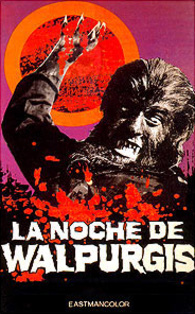Listeners:
Top listeners:
-
 play_arrow
play_arrow
Substrate Radio Freeform Radio From Alabama

By – Gareth Jones

For fans of Paul Naschy, Spanish Exploitation Gothic, early 1970’s cheesy but fun Euro-horror
Jacinto Molina Álvarez, known professionally as Paul Naschy, is one of the most important figures in the development of Gothic Cinema and Spanish Cinema as well. Born in 1934, he grew up during the Spanish Civil War and lived during the fascist regime of Franco. As a child, he saw Frankenstein Meets the Wolfman, the Universal film from 1943. He was immediately connected to the Lon Chaney Wolfman character. After becoming a professional bodybuilder, Naschy became involved in the film industry and was able to manifest this passion in the creation of his own wolfman character, the polish Count Waldemar Daninsky who suffered from lycanthropy. He went on to play this character 12 different times, a record for any actor playing the werewolf. Lon Chaney Jr. only played it seven. Naschy went on to be in well over 100 films during his career but no character he played or created matched that of Waldemar Daninsky or “El Hombre Lobo” as he was known in Spain.
 Walpurgis Night or The Werewolf vs. the Vampire Woman as it was known in the United States was the fifth time Naschy played the role. He also wrote the script, something he did often. The film is directed by Euro-Horror master León Klimovsky Dulfán, an Argentine director who from 1947-1978 directed 75 films, many with Paul Naschy as the lead. This film is considered their best and after watching several Naschy films in preparation for teaching about him, I have to agree. They all have their charms, but this one has several specific elements that make it shine a bit brighter.
Walpurgis Night or The Werewolf vs. the Vampire Woman as it was known in the United States was the fifth time Naschy played the role. He also wrote the script, something he did often. The film is directed by Euro-Horror master León Klimovsky Dulfán, an Argentine director who from 1947-1978 directed 75 films, many with Paul Naschy as the lead. This film is considered their best and after watching several Naschy films in preparation for teaching about him, I have to agree. They all have their charms, but this one has several specific elements that make it shine a bit brighter.
The story is your template Gothic story. Two young female students investigating the story of the remains of the murderess Countess Wandessa Darvula de Nadasdy, get stranded in an isolated village, specifically at the mansion of one Waldemar Daninsky, who has been revived as a werewolf by two doctors who remove the silver bullets from his body. The wonderful thing about a Naschy film is that all of the plot is designed to just create battles between monsters much like his beloved Frankenstein vs. the Wolfman. His love for this character and the monstrous is evident in his fantastic performance. His bulky body works well in the transformation scenes and he makes for an intriguing seducer/lover for the required sex scenes. The gore is over the top and in the tradition of Hammer and Italian Horror, but with a Spanish mix. This mix of just putting multiple monsters and stories into one film is playful and gives audiences a bang for their buck, so to say.
One of the elements that really stands out in the film is the character of the Countess Wandessa, who seduces men and women, but in particular one of the two students. There appears to be genuine love between the two vampiric figures. The slow motion sequences of their attacks are also extraordinary, recalling the Japanese wire work from classics such as Kuroneko, Onibada, and Kwaiden. Again, the manner in which Naschy and Klimovsky combine so many Gothic elements into a paella (my apologies) of horror is admirable.
The exploitation elements take on an additional meaning when one considers when the film was made. The Franco regime did not fully end until 1975, so just making a film with this type of content was a form of resistance and revolutionary in the Spanish film industry. Similarly to the way that Italian giallo and horror was a statement on the Catholic Church, these films were exploiting sex and violence as a way to confront the oppressive regime.
If any of this sounds interesting to you, many of Paul Naschy’s werewolf films are readily available on TUBI.
Written by: Gareth Jones
Similar posts
Recent Comments
Featured post

Latest posts
Current show

Meeting People Is Easy
With Jason and a bus stop full of friends
For every Show page the timetable is auomatically generated from the schedule, and you can set automatic carousels of Podcasts, Articles and Charts by simply choosing a category. Curabitur id lacus felis. Sed justo mauris, auctor eget tellus nec, pellentesque varius mauris. Sed eu congue nulla, et tincidunt justo. Aliquam semper faucibus odio id varius. Suspendisse varius laoreet sodales.
closeUpcoming shows

Afternoons With Substrate
Your personalized afternoon
12:00 pm - 6:59 pm
The Classic Hip Hop Show
With Supreme
7:00 pm - 8:59 pm
Through The Night With Substrate
Cruisin' With Substrate Radio
9:00 pm - 11:59 pm
Early Morning With Substrate
Jason's playlist just for you
12:00 am - 8:59 am
Sleep in Cinema
Presented by Craig and Gareth
9:00 am - 9:59 amChart






















